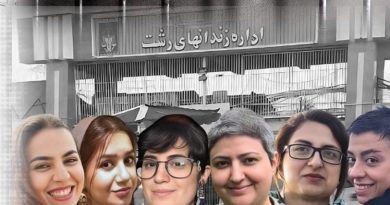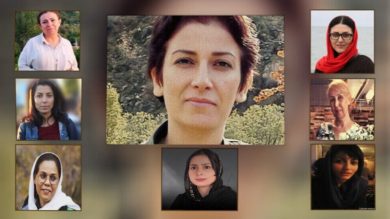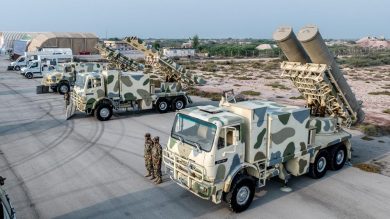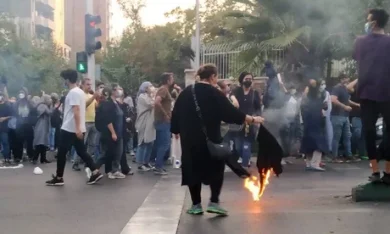In the face of brutal repression by the Islamic Revolutionary Guard Corps (IRGC), Iranian activists continue to risk their lives to demand freedom, human rights, and justice. These activists—comprising women, students, journalists, ethnic minorities, and others—have become symbols of courage, inspiring global solidarity in their struggle against authoritarian control. This article highlights the personal stories of Iranian activists, their fight against the IRGC, and the global support needed to sustain their movement.
1. Mahsa Amini’s Legacy and the Women, Life, Freedom Movement
The death of Mahsa Amini in 2022 sparked one of the largest protest movements in Iranian history. Arrested for allegedly violating mandatory hijab laws, Amini died in police custody, with reports of severe abuse. Her death ignited nationwide protests, led largely by women and young people, under the slogan “Women, Life, Freedom.”
A. Stories from the Frontlines
• Shirin, a 22-year-old university student, was arrested for removing her hijab during a protest. After weeks in detention, she was released but continues to face harassment and threats.
• Neda, a high school teacher, has organized secret meetings to support women’s rights. Despite the risks, she remains committed to educating young girls about their rights.
B. Defiance Through Civil Disobedience
Iranian women are defying the IRGC’s control through acts of resistance such as publicly removing their hijabs, burning headscarves, and organizing peaceful protests. These symbolic acts have inspired international support for their fight.
2. Student Activists Leading the Fight for Academic Freedom
Iranian students have played a pivotal role in resisting authoritarian rule, demanding freedom of speech, academic rights, and political reform. Universities have become centers of dissent, often facing violent crackdowns by the IRGC.
A. Stories of Student Resistance
• Ali, a student leader at Tehran University, has organized several on-campus protests against the regime’s policies. He has been detained multiple times but continues to advocate for freedom of education.
• Sara, a law student, uses her social media platform to share videos of protests and document human rights abuses, despite internet shutdowns.
B. Repression and Arrests
• The IRGC has targeted student unions and pro-democracy organizations, with dozens of student activists arrested and expelled from universities.
• Many students are subjected to intense surveillance, with cyber units monitoring their communications and social media accounts.
3. Ethnic and Religious Minority Activists
Iran’s ethnic and religious minorities, including Kurds, Baloch, Arabs, and Bahá’ís, have faced longstanding discrimination and systematic repression. The IRGC frequently labels minority activists as “separatists” or “terrorists”, using this as a pretext for military crackdowns.
A. Stories of Courage from Minority Activists
• Ramin, a Kurdish activist, has documented human rights violations in his region, risking arrest and torture to raise awareness. His work has been used by international human rights organizations.
• Fatemeh, a Baloch teacher, leads education initiatives in underserved communities, despite facing constant threats from local authorities.
B. Regional Crackdowns
• The IRGC has conducted military operations in minority regions, leading to mass arrests, forced displacement, and extrajudicial killings.
• Activists from these regions continue to fight for cultural and political rights, often at great personal risk.
4. Journalists and Whistleblowers Exposing the Regime
Iranian journalists and whistleblowers play a crucial role in exposing the IRGC’s human rights abuses, despite working under one of the most repressive media environments in the world.
A. Stories of Media Resistance
• Zahra, a journalist for an independent Persian-language news outlet, has faced multiple threats for reporting on protests and executions.
She continues her work in exile, helping provide uncensored information to Iranians.
• Mehdi, a whistleblower from within the government, leaked classified documents revealing the extent of IRGC corruption and violence. He has since gone into hiding.
B. Censorship and Harassment
• The IRGC controls state media and routinely censors independent journalism.
• Journalists face arbitrary detention, show trials, and torture, with many forced to flee the country.
5. Digital Activists and Cyber Resistance
With the Iranian government enforcing internet shutdowns during protests, digital activists have become essential to maintaining communication and spreading information. These activists work to bypass censorship and document abuses in real time.
A. Stories of Digital Resistance
• Arash, a cybersecurity expert, provides VPNs and encrypted communication tools to activists across Iran. His efforts have helped protesters organize safely despite IRGC surveillance.
• Laila, a social media activist, has gained international attention by posting footage of IRGC crackdowns, raising awareness and mobilizing support worldwide.
B. Cyber Warfare Tactics
• The IRGC’s cyber units use hacking, phishing attacks, and disinformation campaigns to disrupt activist networks.
• Digital activists face constant cyberattacks and account takeovers aimed at silencing their voices.
6. The Role of the Global Community
A. International Protests and Advocacy
• Iranian diaspora communities have organized global protests in solidarity with activists, demanding international action against the IRGC.
• Activists have called for stronger sanctions on IRGC officials responsible for human rights abuses.
B. Support from Human Rights Organizations
• Organizations like Amnesty International and Human Rights Watch have documented violations, providing evidence to the UN and other international bodies.
• Efforts to provide asylum and legal protection to activists at risk have intensified.
7. Recommendations for Global Action
To support Iranian activists and hold the IRGC accountable, the international community should:
1. Expand Sanctions
Target IRGC leaders and financial networks to limit their ability to fund repression.
2. Support Digital Freedom
Provide secure communication tools, VPNs, and training to protect activists from cyber attacks.
3. Advocate for Human Rights
Demand independent investigations into IRGC atrocities and pressure Iran to comply with international human rights treaties.
Conclusion
The courage of Iranian activists fighting for freedom and justice is a testament to the resilience of the human spirit in the face of oppression. Despite IRGC violence and repression, these individuals continue to inspire global solidarity. Their stories remind us that freedom is a universal right, and it is the responsibility of the international community to support their struggle.
Join Our Newsletter!
Stay informed with the latest updates, news, and ways to take action in the fight for justice and global security. Sign up now to get updates delivered straight to your inbox!





